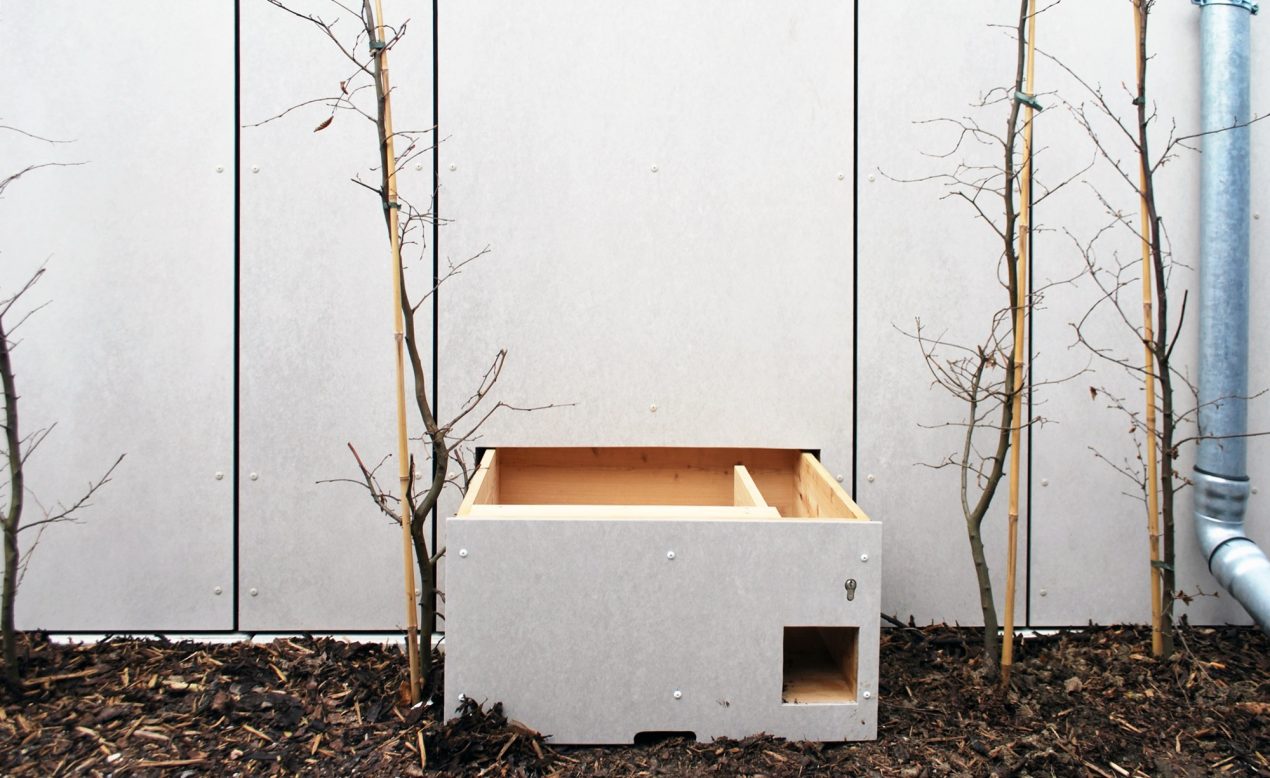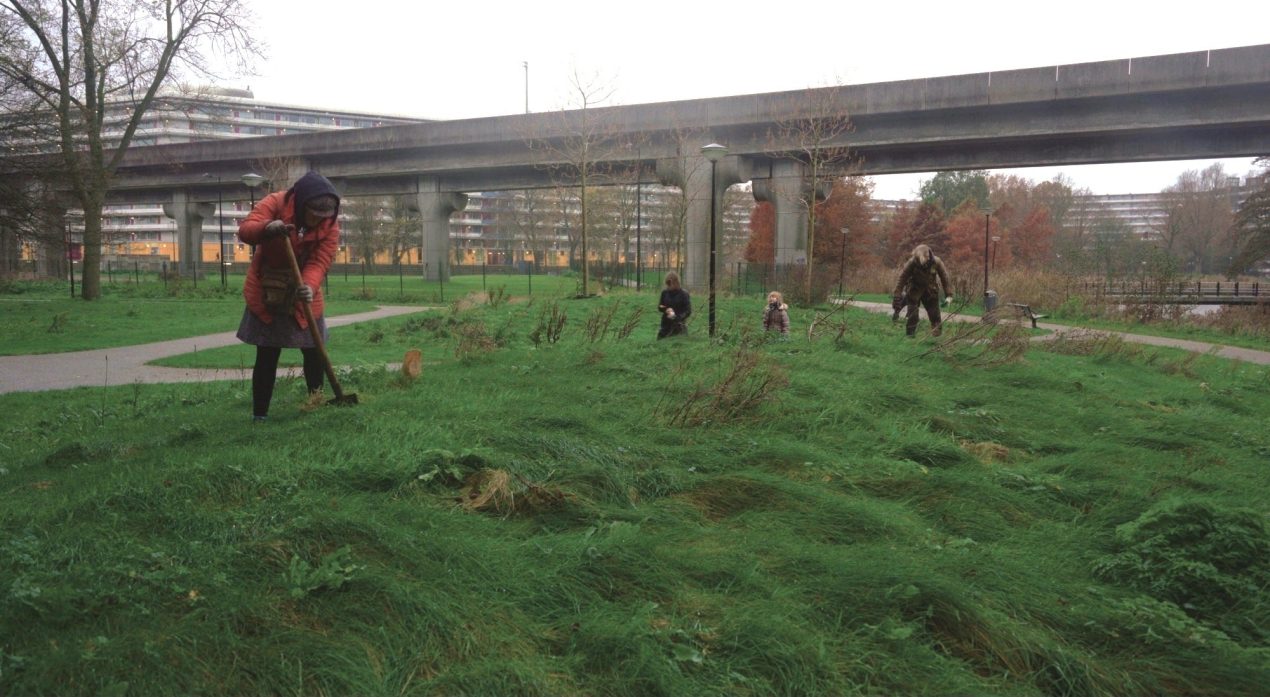Forces & Frictions ↓ Climate Change (38) Climate Migration (2) Deforestation (5) Densification (9) Dispossession (9) Eco-gentrification (9) Environmental Degradation (16) Extraction (7) Flooding (6) Gentrification (10) Pollution (10) Rewilding / Renaturalization (8) Surveillance / Panopticism (4) Touristification (5) Urbanization (24) Sites & Situations ↓ Airports (7) Arid Landscapes (6) Burial Sites (1) Coastal Landscapes (4) Digital Realm (6) Dikes (4) Extraction Sites (6) Festival Grounds (6) Forests (17) Golf Courses (4) Harbour Areas (1) Mountains (2) Pleasure Gardens (13) Polders (1) Post-industrial (6) Prairie (1) Pyro-Landscapes (3) Rivers / Riparian Landscapes (5) Rooftops (5) Ruins (9) Suburban Lawn (8) Supply Chain Landscapes (2) Underground (2) Underpass (1) Urban Metropolis (8) Wastelands (6) Methods & Mediations ↓ Abstraction (8) Activism (10) Acupuncture (1) Adaptive Reuse (13) Adumbration (1) Applied Philosophy (2) Associations & Conferences (83) Awards (37) Books (44) Calls & Opportunities (2) Care (12) Critique (29) Disruption / Dissonance / Dissensus (9) Drawing (7) Estrangement (5) Exhibitions (20) Fail Better (3) Film & Video (12) Generative Design (3) Journals and Zines (6) Maintenance (5) Mapping / Cartography (7) Mapping Practice (32) Mimesis (1) Model-making (4) Mood boards (2) Nature-Based Solutions (NBS) (6) Objectification (4) Objets Trouvés (5) Permissive Design (4) Photography (23) Play (10) Provocation (6) Reappropriation (6) Research (19) Speculative Design (4) Teaching / Pedagogy (13) Topography (2) Topology (2) Undoing (1) Concepts & Theories ↓ Alienation (6) Animism / New Animism (1) Anthropocene (28) Authorship (13) Biourbanism (4) Cabinet of Curiosities / Wunderkammer (3) Capitalocene (8) Correlationism (3) Creative Destruction (6) Decolonisation (17) Design with Nature (McHarg) (1) Digital Product Passport (2) Distribution of the Sensible (Ranciere) (3) Dystopia (4) Eco-Cathedral (2) Emancipated Spectator (Ranciere) (2) Emancipation (6) Estrangement (Shklovsky) (3) Eva Horn (1) Feminism (6) Forest Urbanism (7) Gaia Hypothesis (1) Genius Loci (2) Greenwashing (6) Half-Earth (2) Heterotopia (6) Horizon (3) Incomplete / Incompiuto Siciliano (2) Interdependency (1) Justice / Ethics (32) Land Ethic (5) Landscape Convention (2) Landscape Literacy (7) Messy Ecosystems, Orderly Frames (3) Metaphor (10) Modernism (5) Nature-Culture Dialectics (26) Onto-Cartography (1) Ontopoetics (2) OOO – Object-Oriented Ontology (4) Operational Landscape (5) Paradigm Shift (Kuhn) (4) Perception (31) Picturesque (6) Planetary Urbanization (10) Pluriversalism (1) Posthumanism (14) Postmodernism (2) Postnatural (3) Production of Nature (12) Pyro-Gardening (2) Pyrocene (3) Queer (2) Ready-to-hand / Present-at-hand (3) Relative Universalism (1) Representation (30) Resilience (16) Resolution / Low-Res (7) Retreat (2) Rhizome (2) Right to the City/Landscape (6) Risk (10) Safety (2) Scale (6) Set-Theoretic Ontology (1) Simulacra & Simulation (1) Smooth/Striated Space (1) Speculative Realism (1) Surplus (4) Symbiocen / Symbiosis (1) Technocene (1) Temporality (14) The Ignorant Schoolmaster (Rancière) (1) The Third Thing (1) Third Landscape (Clément) (7) Urban Political Ecology (27) Utopia (8) Void (1) Walking / Strollology / Dérive (3) Wastewater Urbanism (2) World-Ecology (28) Disciplines & Dispositions ↓ Aesthetics (37) Agriculture (6) Anthropology (11) Architecture (18) Art (24) Botany (3) Entomology (2) Environmental Psychology (11) Forestry (12) Geography (5) Geology (3) Heritage (16) History (23) Hydrology (5) Land Art (10) Landscape Architecture (99) Mental Health Care (3) Pedology (5) Phenomenology (9) Philosophy (22) Planning (12) Politics of Public Space (47) Urbanism (23) Matter & Media ↓ Atmosphere / Air (5) Concrete (3) Data / Code (7) Fire (4) Ice / Permafrost / Glaciers (2) Light (0) Noise / Sound (4) Plastic (2) Sand (4) Soil (15) Steel / Iron / Rust (2) Stone / Rock (3) Trash / Waste (4) Wastewater/Stormwater (4) Water (14) Assemblages & Living Agencies ↓ Actor-Network Theory (ANT) (1) Animal (10) Artificial Intelligence (4) Biodiversity (23) Body (5) Children (2) Co-habitation (24) Collective Agency / Self-Organization (16) Conviviality (1) Ethnobotany / Plant Knowledge (11) Fauna (14) Indigenous Communities (8) Migrating Species (8) More-than-human (2) Participatory Processes (13) Performative Planting Design (7) Plant Agency (22) Social Practices (28) Strange Strangers (Morton) (4) Synurbic Species (3) Umwelt (2) Imaginaries & Discursive Sites ↓ Commons (3) Competing City (1) Crisis Landscapes (16) Fourth Nature (1) Healing landscapes (3) Infrascapes (8) Land Ownership (5) Military / Nuclear Sites (3) Nature (27) Natureculture (14) Neoliberal Landscape (8) POPS / Privately Owned Public Space (2) Taskscape (2) Terror / War Sites (1) Third Landscapes / Ruderal (11) Third Nature (3) Third Places (1) Thinkers & Practitioners ↓ Aalto, Alvar (1) Agamben, Giorgio (1) Agassiz, Louise (1) Albrecht, Glenn (1) Aloi, Giovanni (2) Alphand, Adolphe (1) Andersson, Sven-Ingvar (5) Andersson, Thorbjörn (3) Antrop, Marc (1) Aquinas, Thomas (1) Arana, Usue Ruiz (1) Arboleda, Martín (1) Aristotle (2) Badiou, Alain (1) Bajc, Katarina (1) Bakshi, Anita (1) Balmori, Diana (1) Balog, James (1) Bargmann, Julie (1) Barnett, Rod (1) Benjamin, Walter (3) Berrizbeitia, Anita (3) Birgens, Mads (1) Birnbaum, Charles (3) Blanchard, Hortense (1) Blenkuš, Matej (1) Bloch, Ernst (1) Bluwstein, Jevgeniy (1) Bookchin, Murray (1) Bormann, Herbert (1) Bourel, Paul (1) Bourriaud, Nicolas (1) Brandt, Denise Hoffman (2) Brenneisen, Stephan (1) Brenner, Neil (4) Brezar, Zaš (37) Brunier, Yves (1) Brunsing, Fabian (1) Bryant, Levi (1) Burckhardt, Lucius (2) Bélanger, Pierre (3) Cage, John (1) Cane, Jonathan (1) Carson, Rachel (1) Casagrande, Marco (1) Casid, Jill (1) Certeau, Michel de (1) Cervera, Marina (1) Champagne, Alexandre (1) Church, Thomas (2) Cipriani, Laura (1) Cisani, Margherita (1) Clément, Gilles (8) Corajoud, Michel (3) Corboz, André (1) Corbusier, Le (3) Cormier, Claude (1) Cowles, Sarah (2) Cramer, Menno (1) Darwin, Charles (1) Dawkins, Richard (1) Deijs, Dingeman (1) Dekker, Andre (1) Delbaere, Denis (1) Deleuze, Gilles (3) Denizen, Seth (2) Dennett, Daniel (1) Derrida, Jacques (2) Descartes, Rene (3) Descola, Philippe (1) Descombes, Georges (7) Desportes, Marc (1) Deutinger, Theo (1) Dhont, Erik (1) Diedrich, Lisa (8) Dolar, Mladen (1) Dyne, George Van (1) Easterling, Keller (1) Edgeworth, Matt (1) Eichner, Sara (1) Elden, Stuart (1) Eliasson, Olafur (1) Elkin, Rosetta S. (5) Emmerik, Joost (5) Flaquer, Berta (1) Fort, Tom (1) Foucault, Michel (6) Fouts, Roger (1) Freud, Lucian (1) Freud, Sigmund (1) Freytag, Anette (2) Friedberg, M. Paul (3) Furness, William (1) Gallagher, Frank (1) Ganz, Daniel (1) Gardner, Beatrix (1) Gardner, R. Allen (1) Geballe, Gordon (1) Geest, Léon van (1) Gessel, Michael van (2) Girot, Christophe (3) Goodall, Jane (1) Gould, Stephen Jay (1) Graham, Dan (1) Guattari, Félix (2) Guculak, Vladimir (1) Haeckel, Ernst (1) Halprin, Anna (1) Halprin, Lawrence (1) Handel, Dan (1) Haraway, Donna (5) Hardin, Garrett (1) Harman, Graham (3) Havik, Klaske (2) Heidegger, Martin (4) Hilderbrand, Gary (3) Hirst, Gabriella (1) Hogue, Martin (1) Hopstock, Lars (1) Huizinga, Johan (1) Hunt, John Dixon (2) Husserl, Edmund (1) Hutton, James (1) Huxley, Thomas Henry (1) Illich, Ivan (1) Ingold, Tim (2) Jacobs, Jane (1) Jakob, Michael (3) Jazeel, Tariq (1) Jenkins, Virginia Scott (1) Jung, Carl Gustav (1) Kallipoliti, Lydia (1) Kandjee, Thierry (1) Kant, Immanuel (2) Kaufman, Donielle (1) Kienast, Dieter (2) Kiley, Dan (1) Kimmerer, Robin Wall (1) Kliass, Rosa (1) Knapas, Rainer (1) Korman, Yaniv (1) Kowarik, Ingo (1) Kurir, Mateja (2) Kurz, Peter (1) Kučan, Ana (4) Lacan, Jacques (2) Latini, Luigi (6) Latour, Bruno (2) Lauterbach, Iris (1) Lee, Abra (1) Lefebvre, Henri (2) Leopold, Aldo (1) Linnet, Jens (1) Long, Richard (1) Lord, James A. (2) Louafi, Kamel (1) Lynch, Kevin (1) Lyotard, Jean-François (1) Lörzing, Han (1) Madl, Andrew (1) Maldiney, Henri (1) Maltby, Elliott (1) Marx, Roberto Burle (4) masharu (1) Mattern, Hermann (1) McGowan, Todd (1) McHarg, Ian (4) Meier, Nicole (1) Meillassoux, Quentin (1) Menatti, Laura (1) Mente, Eleni (1) Meulder, Bruno De (1) Midgley, Mary (1) Migge, Leberecht (2) Milovanović, Danilo (1) Miss, Mary (2) Mitchell, W. J. T. (3) Moore, Jason (1) Moore, Kathryn (1) Morton, Timothy (3) Moura, Eduardo Souto De (1) Muršič, Zarja (1) Musharbesh, Tamer-Georges (1) Nagel, Thomas (1) Nassauer, Joan Iverson (1) Negarestani, Reza (1) Negrotti, Massimo (1) Neumann, Rod (1) Nielsen, Signe (1) Noe, Christine (1) Noest, Marit (1) Norberg-Schulz, Christian (1) Notre, André le (2) Nottage, Tim (1) Nunes, João (2) Oberlander, Cornelia Hahn (4) Ogrin, Dušan (2) Oldenburg, Ray (1) Olin, Laurie (1) Olmsted, Frederick Law (6) Olwig, Kenneth (3) Ostrom, Elinor (1) Osuldsen, Jenny B. (2) Pallasmaa, Juhani (1) Palmquist, Beatrice (1) Pattison, Harriet (1) Pedersen, Kristoffer Holm (1) Pell, Richard (1) Penfornis, Sébastien (1) Perrin, Carmen (1) Peterson, Dale (1) Plato (1) Prominski, Martin (1) Provoost, Michelle (1) Pyne, Stephen (1) Raby, Dunne & (1) Radić, Gaia (1) Ramutsindela, Maano (1) Rancière, Jacques (3) Rebellion, Extinction (1) Reclus, Élisée (1) Reich, Lilly (1) Rein-Cano, Martin (2) Reisewitz, Caio (1) Relph, Edward (1) Repton, Humphry (1) Ricœur, Paul (1) Robbins, Paul (1) Robin, Libby (1) Roelofs, Jolle (1) Rohe, Mies van der (3) Rosa, Hartmut (1) Rosich, Montserrat Bonvehi (1) Rowe, Colin (1) Roy, Louis le (2) Ruff, Scott (1) Sandru, Razvan (1) Saviñón, Susana Rojas (1) Schiller, Friedrich (1) Schneekloth, Lynda H. (1) Scholtes, Alexander Joseph (1) Schouten, Matthijs (1) Schäfer, Robert (6) Scott, Ridley (1) Sennett, Richard (1) Shannon, Kelly (3) Shklovsky, Viktor (3) Simons, Tom (1) Sjödahl, Elisabeth (1) Skjulhaug, Sebastian Guha (1) Smithson, Robert (2) Snaith, Bridget (1) Solomon, Debra (2) Spencer, Herbert (1) Spirn, Anne Whiston (4) Steinberg, Ted (1) Stiles, Richard (1) Stokman, Antje (2) Straub, Dietmar (1) Strecker, Amy (1) Sørensen, C. Th. (3) Tafuri, Manfredo (1) Tank, Zoë (1) Tarkovsky, Andrei (2) Teyssot, Georges (1) Tharp, Marie (1) Thurmayr, Anna (1) Tisma, Alexandra (1) Tozzi, Lucia (1) Tredici, Del (0) Tredici, Peter Del (1) Treib, Marc (5) Tsing, Anna (1) Valkenburgh, Michael Van (3) Vassal, Lacaton & (1) Vionnet, Corinne (1) Vogt, Günther (1) Wallace, David A. (1) Warhol, Andy (1) Waterman, Tim (3) Weber, Max (1) Weilacher, Udo (2) Weinberger, Lois (2) Williams, Raymond (2) Williams, Rhys (2) Wilson, Edward O. (1) Winogrond, Robin (1) Wyllie, Roderick (2) Young, Liam (3) Zanon, Simonetta (2) Zhang, Zihao (1) Zumthor, Peter (2) Zupančič, Alenka (2) Şanal, Alexis (1) Škerl, Urška (52) Žižek, Slavoj (1)

